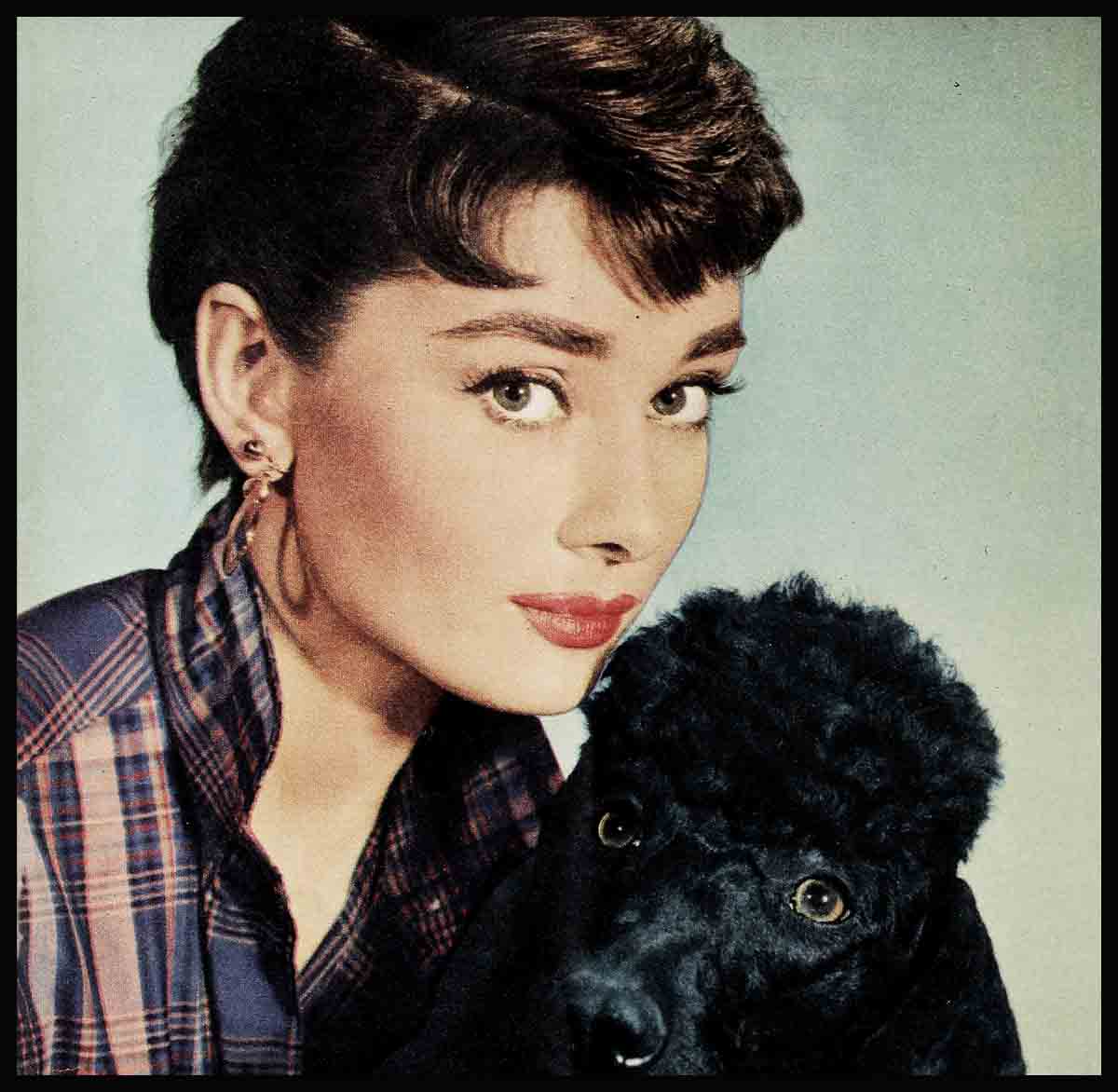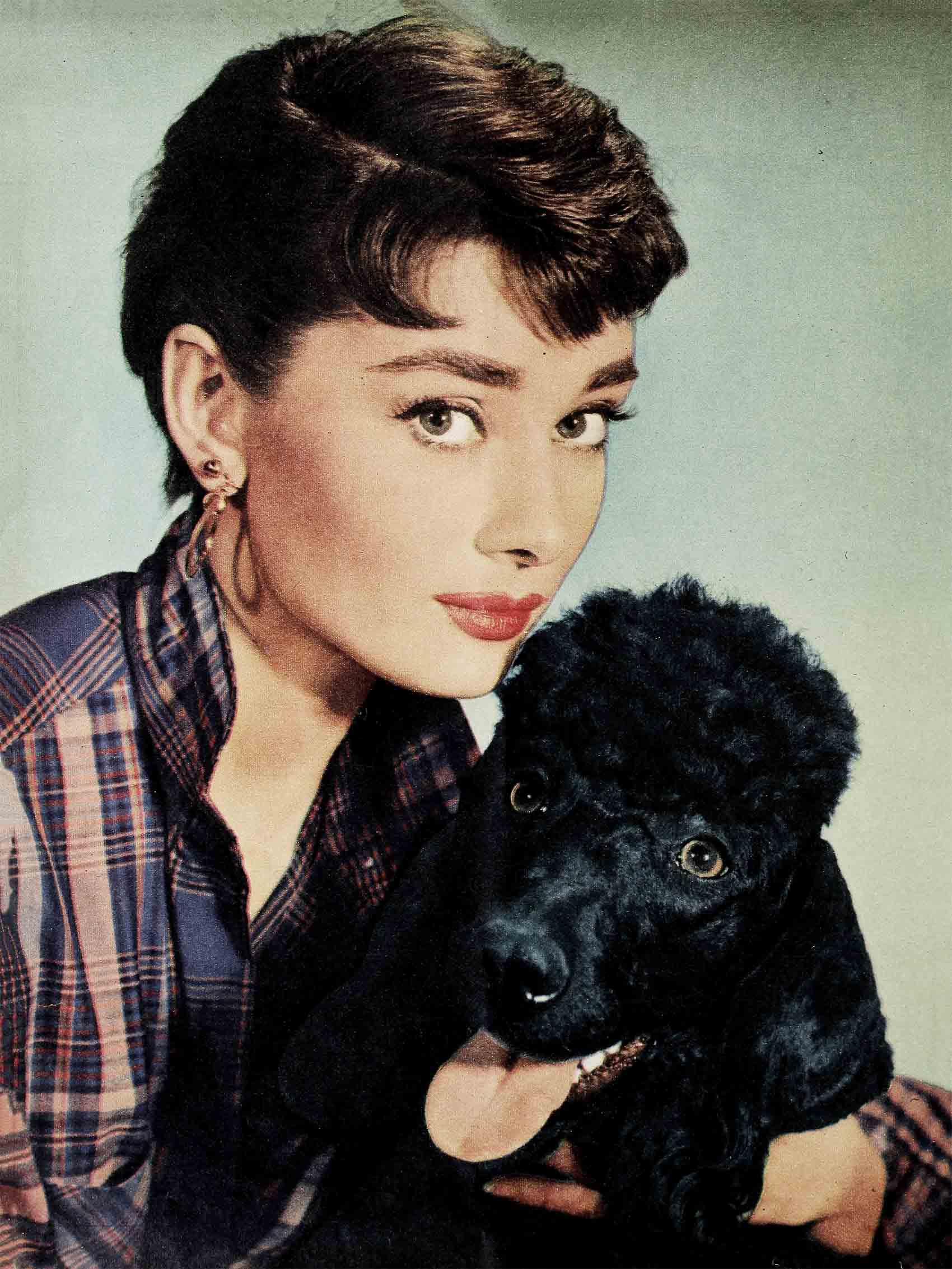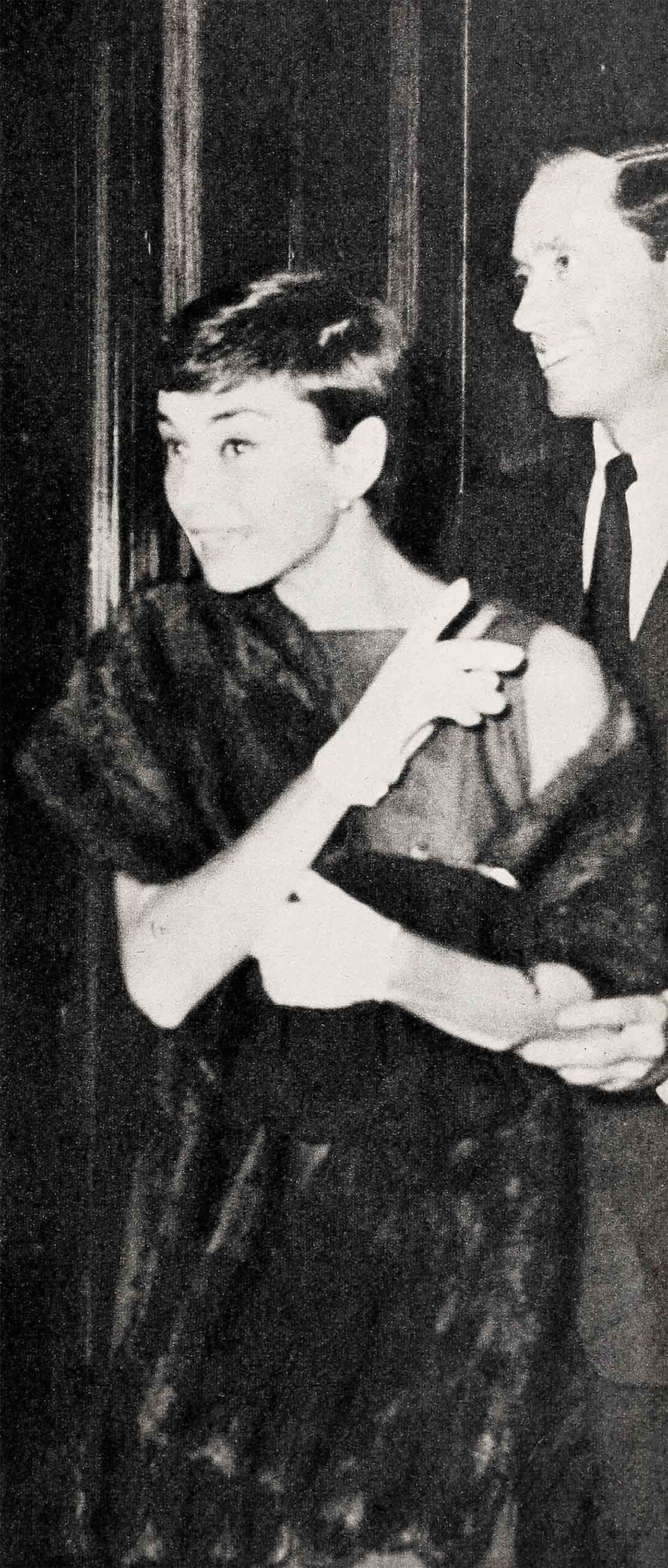
It Just Happened—Audrey Hepburn
Until the very last moment before her marriage, Audrey Hepburn was under pressure to drop Mel Ferrer.
Audrey’s mother, the Baroness van Heemstra, had opposed Ferrer from the very beginning of the romance. She had pointed out to Audrey that Ferrer had been married three times, that he had four children to support, that opinion of his character and talent was amazingly divided.
Audrey had made up her mind.
“I’m in love with Mel,” she told her mother last September, “and I’m going to marry him. I don’t care what anyone says.”
The Baroness van Heemstra tried to reconcile herself to the inevitable.
“What she did not want,” said one of her friends, “was the usual Hollywood clambake. She wanted her daughter to be married with dignity. She called Sir Neville Bland, the former British ambassador to Holland, and asked if he would give Audrey away. Audrey’s real father is a notorious British Fascist, one of Sir Oswald Mosley’s Black Shirts, and the family will have nothing to do with him.
“Sir Neville Bland said he would be honored to give Audrey away. The baroness wasn’t sure when and where the wedding would be held, but she would certainly let him know in plenty of time.” Audrey and Mel decided to be married in Europe for several reasons. Audrey is European and most of her family lives in Europe. It would be easier to avoid the press in Europe. Mel thought he might have to start a film in Rome after their honeymoon. Audrey thought she might have to make a picture in London. She is under contract to a British film company which has loaned her out to Paramount.
On Saturday, September 25, Audrey and Mel were married in a tiny Swiss mountain chapel at Burgenstock, a resort above Lake Lucerne.
On Monday, MODERN SCREEN received this cabled report from Zurich:
Darling, elfin Audrey Hepburn married Melchior Ferrer, thirty-seven, on Saturday.
In fact, she married him twice, first in a civil ceremony, held in the back parlor of the mayor’s house in Buochs. This is a small town that lies below Burgenstock. The ceremony was in Schweizer Deutsch (Swiss German). Ferrer did not appear to understand very much of it.
The second ceremony took place in the Burgenstock chapel. There are only 220 people in all of Burgenstock, and apparently few of them knew about the wedding.
The chapel is French Protestant, and while Audrey is Dutch Protestant, Ferrer is said to be Roman Catholic.
It was a dreary, dismal, rainy day. Audrey was beautifully dressed. She seemed very small and fragile and frightened. She was wearing a white organdy gown designed by Balmain. On her head was a garland of white roses. She wore white gloves and carried a white prayer book.
Ferrer seemed self-assured. He was wearing a dark suit with a white carnation in his buttonhole.
Until they both stood at the altar, some of Audrey’s friends might have secretly hoped that Ferrer would go the way of Jim Hanson. You know that in 1952 Audrey was engaged to marry James Hanson (he was formerly one of Jean Simmons’ constant dates) after she finished Roman Holiday. Invitations to their wedding were already out in England when Audrey canceled it.

In 1950 it had been the other way around. She was engaged to marry Marcel Le Bon, a French actor who was and is a crooner of sorts. Le Bon was offered a contract in the United States. He left Audrey and went to New York. She was then a chorus girl in High Button Shoes. Le Bon married un American girl instead.
Anyway, with such a background, perhaps some of the twenty-five guests were secretly expecting something unusual to take place at the wedding. Nothing did.
After the ceremony there was a wedding reception at the Burgenstock golf club. By this time a few of the townsfolk had heard of the wedding. A photographer tried to get pictures at the reception. One of the guests smashed his camera.
When newspapermen heard about this in Rome they were very angry. Ferrer had been staying in Rome. Reporters who had asked his press agent, Hank Kaufman, if anything was up, were told, “No, Mel is merely flying up to Switzerland for a little vacation. He will be back in a week.”
Kaufman said later that Ferrer had never mentioned the wedding to him.
Audrey and Mel stayed at their reception two hours, drank a little champagne and then left for their honeymoon hideaway in the Swiss Alps for two days.
Then they took a train to Rome. At the railroad station, the press descended but Audrey and Mel were not giving interviews. They were still on their honeymoon, they said, and they wanted to be left alone.
They got into a car and headed for Cinecitta, Rome’s Hollywood, with the press in wild pursuit.
Further cables from Europe reported that in an effort to escape reporters and photographers, the Ferrers went to Albano, a village 120 miles from Rome.
There in a twenty-room stone villa, Ferrer bolted all the doors and refused to talk.
Italian movie producer Vittorio Forges Davanzati, a friend, finally went out and announced, “The Ferrers have asked me to obtain for them police protection. After all, gentlemen, they are on a honeymoon. I assume many of you have been on a honeymoon. A man does not like having 150 reporters underneath his bedroom window at such a time!”
“All we want,” cried one newspaperman, “is to ask them a few questions, just a few questions.”

“That crazy chauffeur of theirs drove so fast we were almost killed following them,” another reporter cried out.
Audrey and Mel decided to hold a press conference that night.
“When did you fall in love with Mr, Ferrer? When did you decide to marry him?” Audrey was asked.
“When Mel and I were acting together in New York, I said to myself that I would like to get married to him. There was no day nor any particular moment when we fell in love. It just happened. There was an understanding between us after a while that we would get married. I have great faith that it will work out. I am sure it will.”
Sadly enough, the general feeling in Hollywood is that Audrey’s marriage will not work out. Many people believe that Audrey is somehow under Mel’s complete domination. As soon as this breaks, they expect the marriage to come apart.
“I cannot, for the love of me,” said one Hollywood actress who has played opposite Ferrer, “understand what Audrey sees in the man.”
An answer to that comes from Mrs. Florence Vivienne Entwhistle, a professional photographer, who is, incidentally, Sarah Churchill’s mother-in-law. She made some portraits of the actor. These are now in Audrey’s possession.
Said Mrs. Entwhistle, “Some women are fascinated by the nice, miserable expression on Ferrer’s bordering-on-the-plain sort of face. I know I was. He’s a man you feel you must mother. He certainly brought out the maternal in me. It’s that lean and hungry look he has.”
Hollywood, of course, is often incorrect in predicting the courses of marriages.
There is no doubt that Audrey is completely and devotedly in love with her husband. During their courtship he wouldn’t let her out of his sight, and she was content to let him manage her private and professional life. That courtship began last year after Audrey had finished her second Hollywood picture, Sabrina.
Until then there had been no American love affairs for the Dutch-born actress. “I’m so busy with my career,” she had said, “that I haven’t even had time to analyze my innermost thoughts. I’m still in the process of learning about myself. Until I do, there’s no possibility of marriage.”
Then Audrey went to a Hollywood cocktail party and met Mel Ferrer. She knew practically nothing about him.
Later she was to learn that he had been born in New Jersey and had left school to marry sculptress Frances Pilchard. They had gone to Mexico where Mel had tried to write. They had two children, Pepa and Mark. Then Mel had drifted away from Frances. After their divorce he became interested in stage work.
He married Barbara Tripp and they had two children, Mela and Christopher. This marriage also ended in divorce and in 1942, Mel remarried his first wife.
After their second marriage Mel and Frances separated frequently. During one of these separations Mel found Audrey.
When Ferrer got the rights to a French play, Ondine, he convinced Audrey that she would be a natural for the lead. He talked the Playwrights Company into producing the play. Naturally, he would star opposite Miss Hepburn. The Playwrights Company agreed with alacrity.
Soon the word was all over New York: Audrey and Mel were inseparable. No one could talk to Audrey without first checking Ferrer.
In addition, Mel began to tell Alfred Lunt, the director of Ondine, what was wrong with his work. This antagonized several members of the cast who leaked to newspapermen the opinion that Ferrer’s acting was mediocre, his ego enormous, and his hold on Audrey “practically hypnotic.”
About the same time, Audrey’s mother began to hear about her daughter and Mel Ferrer. And she began to worry. Ferrer was still a married man, for one thing.
But not for long.
According to his wife Frances, “He told me that he had fallen in love with Audrey Hepburn, so last December I went down to Juarez in Mexico and I got a divorce.”
So in January, 1954, Mel was free to court Audrey. “Audrey,” he announced, “must be protected from people as if she were royalty.”
Audrey’s mother tried to intervene. Backstage in Boston where Ondine was being tried out, Ferrer asked her, “What have you got against me, anyway?”
The baroness didn’t think he was the right sort of man for Audrey. Audrey was young. She’d had no father to guide her. She had gone to school in Holland during the Nazi occupation. She had gone to England as a refugee. The family had lost most of its money. She had worked as a chorus girl. She had come up the hard way. Certainly, she was entitled to enjoy her success alone. Besides, Mel had been married three times. There were four children to look after. Audrey, at twenty-five, was too young for him. She didn’t want her daughter to get hurt. Her daughter had been doing marvelously well without his intervention. Why didn’t he get out of her life and leave her alone?
Mel told the baroness that he was in love with Audrey, Audrey was in love with him, and that he had no intention of leaving her daughter alone.
He became even more possessive.
Audrey Hepburn is no fatuous, silly little girl. She reads the newspapers and she understands what she reads. She saw what was being written about Mel. She understood that her mother objected to him violently.
In Mel she had a man who would take care of all the details, leaving her free to concentrate on her art. Perhaps she and Mel would become another Lunt and Fontanne, another Vivien Leigh and Laurence Olivier. Here was a man who had been an actor, writer, producer and director. Was she really in love with him? How many men did she know, anyway? She began to worry and she lost weight.
The doctor said she needed a rest. Walter Winchell wrote, “Mel Ferrer is the chief reason Audrey Hepburn’s worn out. They’re in love.”
Audrey and Mel had been inseparable; she had seen him in all circumstances, and she believed he was a good and gentle human being.
She left Ondine and not very long after, Audrey and Mel then discussed marriage plans. Audrey said she would go to Switzerland for a vacation. Mel said he would go to Italy and then join her in Switzerland.
It was September when they were reunited. Audrey Hepburn, the charming, brown-eyed, actress who had started at the top by winning an Academy Award for her first full-length role, became the third Mrs. Mel Ferrer.
THE END
—BY STEVE CRONIN
It is a quote. MODERN SCREEN MAGAZINE JANUARY 1955




